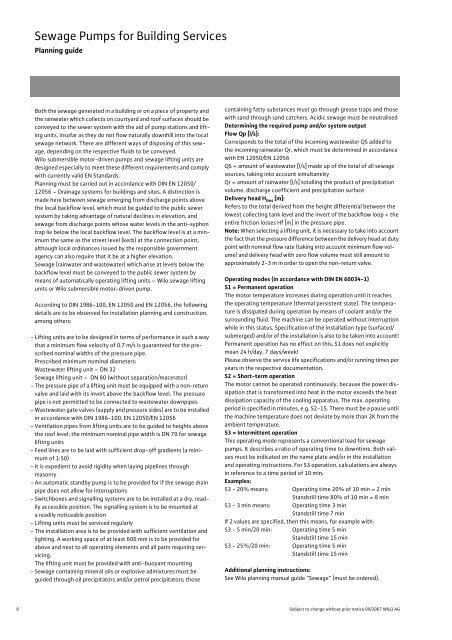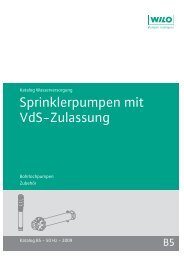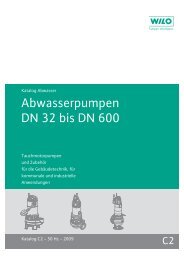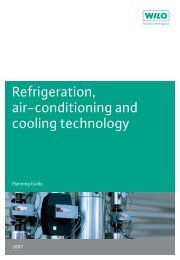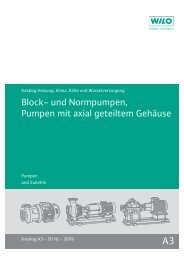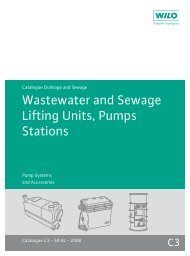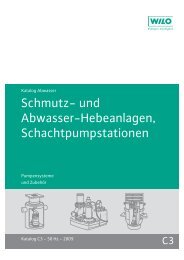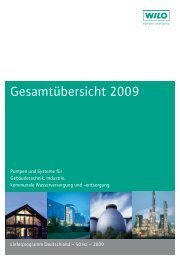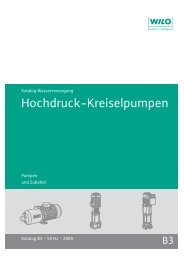C2-Sewage Pumps DN 32 to DN 600 - 2008.pdf
C2-Sewage Pumps DN 32 to DN 600 - 2008.pdf
C2-Sewage Pumps DN 32 to DN 600 - 2008.pdf
You also want an ePaper? Increase the reach of your titles
YUMPU automatically turns print PDFs into web optimized ePapers that Google loves.
l<strong>Sewage</strong> <strong>Pumps</strong> for Building ServicesPlanning guideBoth the sewage generated in a building or on a piece of property andthe rainwater which collects on courtyard and roof surfaces should beconveyed <strong>to</strong> the sewer system with the aid of pump stations and liftingunits, insofar as they do not flow naturally downhill in<strong>to</strong> the localsewage network. There are different ways of disposing of this sewage,depending on the respective fluids <strong>to</strong> be conveyed.Wilo submersible mo<strong>to</strong>r-driven pumps and sewage lifting units aredesigned especially <strong>to</strong> meet these different requirements and complywith currently valid EN Standards.Planning must be carried out in accordance with DIN EN 12050/12056 – Drainage systems for buildings and sites. A distinction ismade here between sewage emerging from discharge points abovethe local backflow level, which must be guided <strong>to</strong> the public sewersystem by taking advantage of natural declines in elevation, andsewage from discharge points whose water levels in the anti-syphontrap lie below the local backflow level. The backflow level is at a minimumthe same as the street level (kerb) at the connection point,although local ordinances issued by the responsible governmentagency can also require that it be at a higher elevation.<strong>Sewage</strong> (rainwater and wastewater) which arise at levels below thebackflow level must be conveyed <strong>to</strong> the public sewer system bymeans of au<strong>to</strong>matically operating lifting units – Wilo sewage liftingunits or Wilo submersible mo<strong>to</strong>r-driven pump.According <strong>to</strong> DIN 1986-100, EN 12050 and EN 12056, the followingdetails are <strong>to</strong> be observed for installation planning and construction,among others:- Lifting units are <strong>to</strong> be designed in terms of performance in such a waythat a minimum flow velocity of 0.7 m/s is guaranteed for the prescribednominal widths of the pressure pipe.Prescribed minimum nominal diameters:Wastewater lifting unit – <strong>DN</strong> <strong>32</strong><strong>Sewage</strong> lifting unit – <strong>DN</strong> 80 (without separation/macera<strong>to</strong>r)- The pressure pipe of a lifting unit must be equipped with a non-returnvalve and laid with its invert above the backflow level. The pressurepipe is not permitted <strong>to</strong> be connected <strong>to</strong> wastewater downpipes- Wastewater gate valves (supply and pressure sides) are <strong>to</strong> be installedin accordance with DIN 1986-100, EN 12050/EN 12056- Ventilation pipes from lifting units are <strong>to</strong> be guided <strong>to</strong> heights abovethe roof level; the minimum nominal pipe width is <strong>DN</strong> 70 for sewagelifting units- Feed lines are <strong>to</strong> be laid with sufficient drop-off gradients (a minimumof 1:50)-It is expedient <strong>to</strong> avoid rigidity when laying pipelines throughmasonry-An au<strong>to</strong>matic standby pump is <strong>to</strong> be provided for if the sewage drainpipe does not allow for interruptions- Switchboxes and signalling systems are <strong>to</strong> be installed at a dry, readilyaccessible position. The signalling system is <strong>to</strong> be mounted atareadily noticeable position- Lifting units must be serviced regularly- The installation area is <strong>to</strong> be provided with sufficient ventilation andlighting. A working space of at least <strong>600</strong> mm is <strong>to</strong> be provided forabove and next <strong>to</strong> all operating elements and all parts requiring servicing.The lifting unit must be provided with anti-buoyant mounting- <strong>Sewage</strong> containing mineral oils or explosive admixtures must beguided through oil precipita<strong>to</strong>rs and/or petrol precipita<strong>to</strong>rs; thosecontaining fatty substances must go through grease traps and thosewith sand through sand catchers. Acidic sewage must be neutralisedDetermining the required pump and/or system outputFlow Qp [l/s]:Corresponds <strong>to</strong> the <strong>to</strong>tal of the incoming wastewater QS added <strong>to</strong>the incoming rainwater Qr, which must be determined in accordancewith EN 12050/EN 12056QS = amount of wastewater [l/s] made up of the <strong>to</strong>tal of all sewagesources, taking in<strong>to</strong> account simultaneityQr = amount of rainwater [l/s] <strong>to</strong>talling the product of precipitationvolume, discharge coefficient and precipitation surfaceDelivery head H Ges [m]:Refers <strong>to</strong> the <strong>to</strong>tal derived from the height differential between thelowest collecting tank level and the invert of the backflow loop + theentire friction losses Hf [m] in the pressure pipe.Note: When selecting a lifting unit, it is necessary <strong>to</strong> take in<strong>to</strong> accountthe fact that the pressure difference between the delivery head at dutypoint with nominal flow rate (taking in<strong>to</strong> account minimum flow volume)and delivery head with zero flow volume must still amount <strong>to</strong>approximately 2-3 m in order <strong>to</strong> open the non-return valve.Operating modes (in accordance with DIN EN <strong>600</strong>34-1)S1 = Permanent operationThe mo<strong>to</strong>r temperature increases during operation until it reachesthe operating temperature (thermal persistent state). The temperatureis dissipated during operation by means of coolant and/or thesurrounding fluid. The machine can be operated without interruptionwhile in this status. Specification of the installation type (surfaced/submerged) and/or of the installation is also <strong>to</strong> be taken in<strong>to</strong> account!Permanent operation has no effect on this. S1 does not explicitlymean 24 h/day, 7 days/week!Please observe the service life specifications and/or running times peryears in the respective documentation.S2 = Short-term operationThe mo<strong>to</strong>r cannot be operated continuously, because the power dissipationthat is transformed in<strong>to</strong> heat in the mo<strong>to</strong>r exceeds the heatdissipation capacity of the cooling apparatus. The max. operatingperiod is specified in minutes, e.g. S2-15. There must be a pause untilthe machine temperature does not deviate by more than 2K from theambient temperature.S3 = Intermittent operationThis operating mode represents a conventional load for sewagepumps. It describes a ratio of operating time <strong>to</strong> downtime. Both valuesmust be indicated on the name plate and/or in the installationand operating instructions. For S3 operation, calculations are alwaysin reference <strong>to</strong> a time period of 10min.Examples:S3 - 20% means: Operating time 20% of 10 min = 2minStandstill time 80% of 10 min = 8minS3 - 3 min means: Operating time 3minStandstill time 7 minIf 2 values are specified, then this means, for example with:S3 - 5 min/20 min: Operating time 5minStandstill time 15minS3 - 25%/20 min: Operating time 5minStandstill time 15minAdditional planning instructions:See Wilo planning manual guide “<strong>Sewage</strong>” (must be ordered).8 Subject <strong>to</strong> change without prior notice 09/2007 WILO AG


